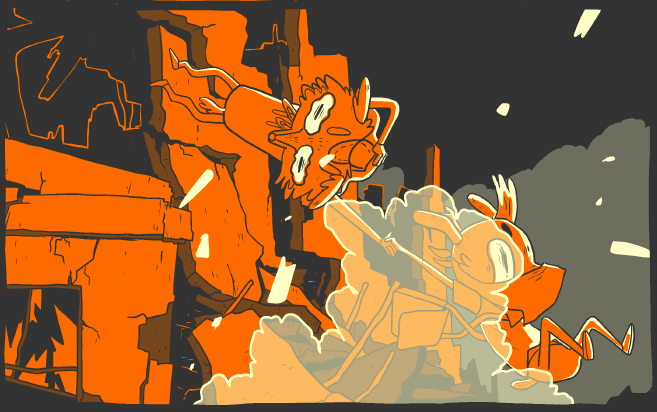Thunderpaw: In the Ashes of Fire Mountain is a comic that literally cannot stop moving. Jen, the comic's creator, has constructed a series of panels made out of looping animated images. The entire comic, in fact, is a study on the various creative ways the often-dismissed animation technique can be used to enhance traditional sequential art.
I mean, just look at all the stuff that Jen throws us in the second page. We begin with the unsettling image of twitchy eyes, with pupils rolling and getting bigger and smaller. Then we have an image of a lightning storm. The sky lights up, and the mountain itself glows then the lightning strikes. Then we get a scene where a flock of birds dive across the sky. Although each image is replayed in a short loop, each panel elicits slightly different reactions: unease, awe, dread.
What's sort of remarkable, though, is how unobtrusive it is. What impresses me is how unobtrusive it is. In a lot of webcomics, an animated sequence is often distracting. Many times, these eye-candy sequences are at odds with the static images directly before and after. Thunderpaw, however, animates everything, and in doing so makes the entire project seem natural. Most of the time, my pupils dart from panel to panel without even considering that it's animated, perhaps because most of it's subtle. Word balloons that change volume every second; characters at rest jitter as if they were animated in Squigglevision. Even captions, which have no business of being animated, squirm ever so subtly on the screen.
Well, except for the times Jen decides Thunderpaw needs to blow your mind. The comic will frequently brighten in a series of rapid-fire flashes ... something that's creeped me out ever since they discovered the same effect in Pokemon cartoons were causing seizures in Japanese children. That's not all: There's always a disconcerting sense of incongruity with regard to the art styles. The color palette seems vintage and dusty, recalling communist propaganda posters from the '40s and '50s. The style, however, is more modern. Although far more polished, Thunderpaw recalls the graffiti-like art styles that made its mark on the black-and-white comics of the '80s and '90s. It makes for some appealingly design characters. It also creates an unnerving feeling that something is off ... especially when the screen explodes into a series of blinking eyeballs.
The story centers around Bruno and Ollie, two dogs in a car that's in the middle of a large traffic jam. Ollie hears thunder, which he suspects is from a supernatural being named Thunderpaw. The next thing he knows, there's a crash, and they suddenly find themselves stranded in a charred, hellish landscape.
The two try to find their way home, a la Homeward Bound but with anthropomorphic dogs in urban streetwear, and with more bad psychedelic acid trips. Bruno and Ollie navigate the war-torn land, with little clues as to what's going on in the world outside their social circle. Are those lasers that are streaking through the sky? Why are there freeways full of abandoned cars? And who is this mysterious stranger that's tracking them down? It's a post-apocalyptic mystery, enhanced by the animation. Shadows flit here and there. The sky flickers with light. It heightens the tension, reminding the reader that things could get very bad at the blink of an eye.

